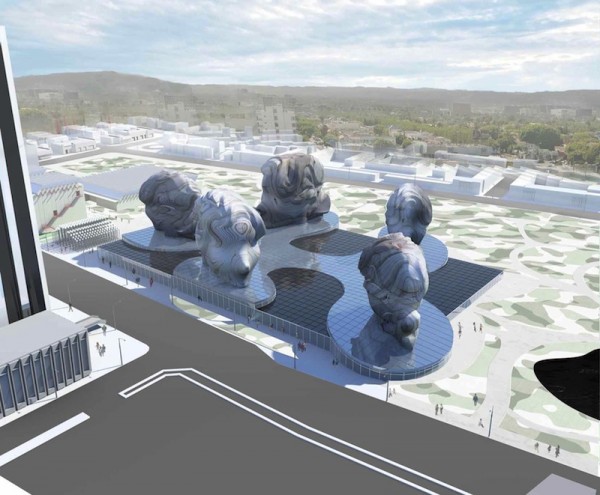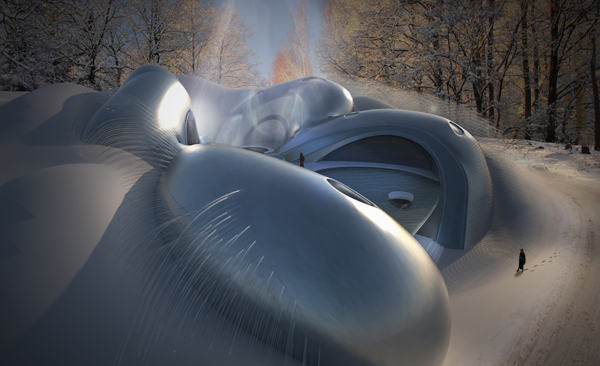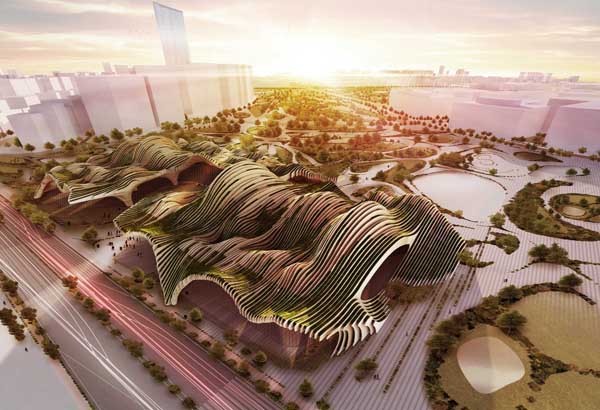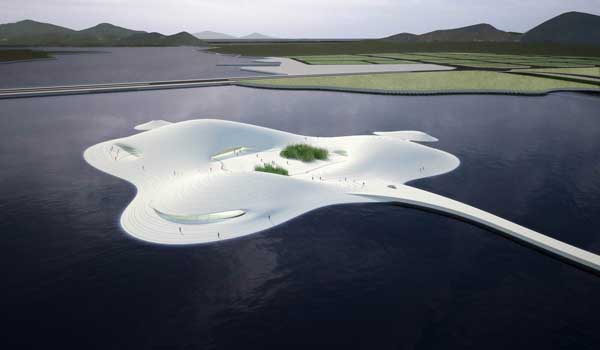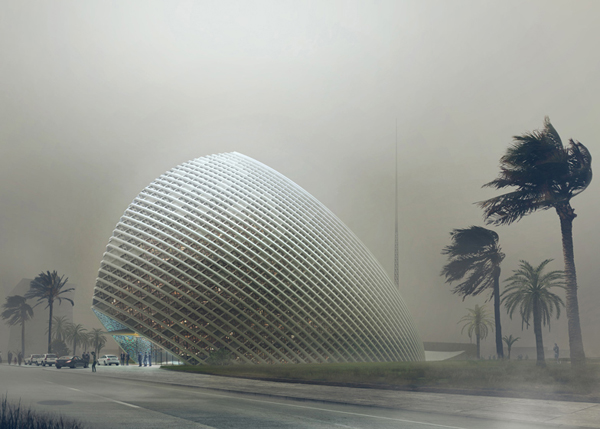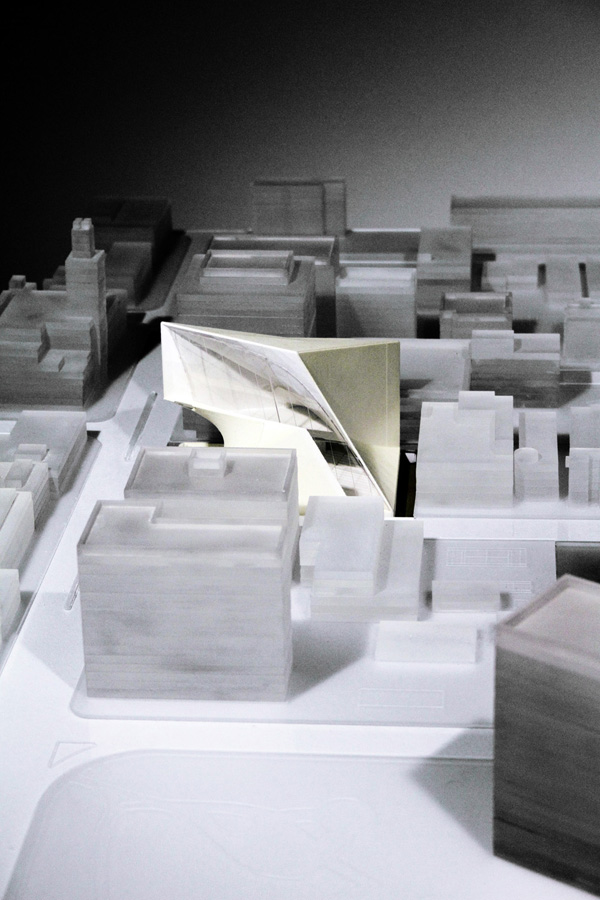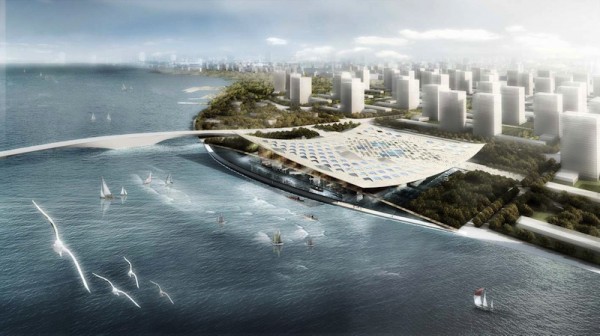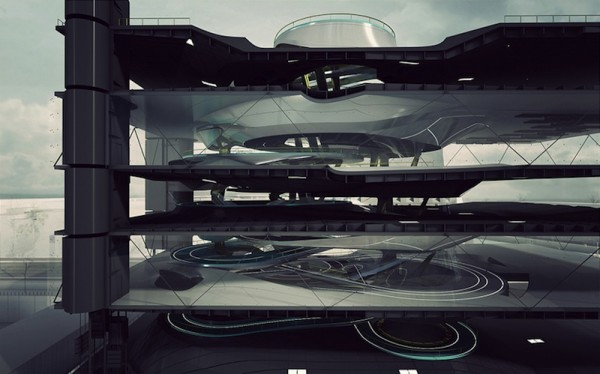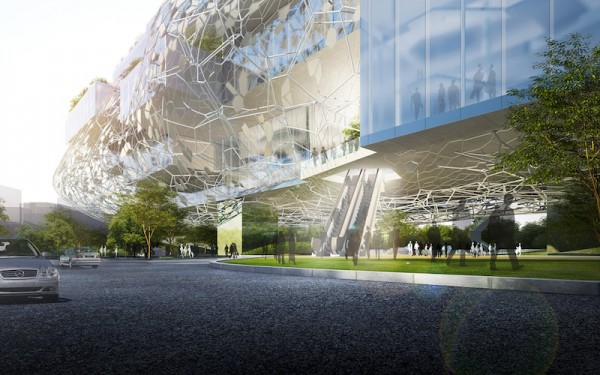Kyle Onaga from the Southern California Institute of Architecture (SCIarc) in Los Angeles asserts that the figure in architecture is neglected and feared; his thesis embraces the figure. The exploration seeks an alternative starting point for architecture that does not originate from abstracted forms. Instead, using a literal figure as massing, the head is taken as the architectural primitive. Read the rest of this entry »
Turning Heads: The Pictorial Figure | LACMA Rethought
Aurora Borealis Arctic Observatory: The Wings Of The Dawn Goddess
Siivet aurora, the Aurora Borealis Arctic Observatory is an architectural project situated in argument between the historic mystic of the northern lights and the urban landmark of Rovaniemi. This proposal by designers Jensen Liu and Sally Hsu explores the awakening moment of the Eos (the goddess of dawn), enhancing a natural phenomenon that continues to amaze audiences. The aurora is signifying the goddess of dawn splitting open the night sky breaking free of the dark skyline. The architectural design symbolizes Eos’s wings responding to the natural aurora phenomenon; as the magnetic field and wind undulates, it follows throughout echoing nature’s best painting. Read the rest of this entry »
Taichung City Cultural Center Competition / Bilbao Architecture Team
Taichung Cultural Center by BAT (Bilbao Architecture Team) grows from the ground – it represents the final oeuvre of sculptural forces of nature, showing the real Taiwan and its magnificent landscape. The design is a proposal for the new city cultural center in the land of mountains, sea and amazing coast. The view from the Taichung Gateway Park shows how the land rises, configuring unique and impressive shapes.
The structure of this astonishing landscape architecture is managed by laminated wood beams of great dept, disposed on a meter distance and joined with lateral connectors. These connectors primarily act as substructure, but they also carry some of the building systems. The roof coverings vary, depending on the functions featured in the interior and their specific requirements. However, the green carpet is the covering for the most of the roof surface, but there are also spaces which demanded great amount of light in the interior, therefore they are covered with glass panels. Solar panels and wood paves areas were also required. Read the rest of this entry »
Floating Pingtan Art Museum By MAD Architects
The largest private museum in Asia, the Pingtan Art Museum, designed by MAD Architects, has just begun its construction preparation phase. Upon its completion, this ambitious private project will display over a thousand pieces of national treasures within its debut exhibition.
In 2010, the “Comprehensive Experimental Zone” project in Pingtan, the largest island in the Fujian province, was launched and the island has been decided to become the primary location for trade and cultural communication between Taiwan and the mainland. The island, currently a military base and a fisheries paradise will quickly be transformed into a large urban development zone.
However, the museum itself acts like a small island on the island, and is connected to land only by an undulating pier, bridging the gap between artificial and natural, city and culture, tradition and future. The building of the museum is an icon and represents a long-lasting earthscape in water.
In the words of the author, the island is firstly a public space, turned into a museum. All the components of its magnificent natural landscape interconnect with each other, forming a harmonious space, with the mountains in the distance. The building of this island museum is constructed in concrete, blended with the local sea shells. The interior space, formed around the movements of its visitors, resembles the ancient caves. Read the rest of this entry »
Sustainable Synergy Of Form, Energy And Tradition: ARPT Headquarters
Mario Cucinella Architects won a competition to design Algeria’s telecommunication agency headquarters. Exquisitely bold, the proposal is rooted in the traditional Mediterranean architecture and it is a re-interpretation of the Algerian landscape and the sand dunes. The building is an icon, and the place where modernity and tradition melt, in form – derived from the Mediterranean tradition and the solar diagram, and in the treatment of the surface of its body.
The dunes in the Algerian desert landscape seem like natural buildings, therefore the architects aimed to mimic the natural environment, avoiding the greater impact of the built structure. However, building had to be highly visible and representative, due to its purpose and the fact that it is situated on a lot along the highway of great importance and is very near to the new urban park Bab Ezzouar. As an institutional building, new ARPT headquarters are designed as a reference point within the neighborhood and a city, a point where tradition merges with modernity in order to create new and unexpected symbolic and cultural scenarios. Therefore, the proposal for the Headquarters is highly iconic, far from traditional aesthetics of the built surroundings, and it exploits the direct contact with the new park area. Read the rest of this entry »
New Center For Contemporary Cinema
Designed by Amir Mikhaeil, the new Center for Contemporary Cinema, situated on the corner of Wilshire Boulevard and Virgil Avenue in Los Angeles, is neither a multiplex nor a museum – it aims to be a new manifold for projection of film and new media within the city. This inspiring design, awarded H.I.Feldman Prize at Yale, has its roots in Tarkovsky’s representation of time in cinema and the Deleuzian conception of the time-image which is not reliant on the linear progression of movement through film, therefore the project disrupts the continuous urban narrative structure of the boulevard.
The dynamic mass of the Center turns as the building rises, creating an internal cascading atrium, directed by two primary hyperbolic surfaces. The theater is consisted of two main blocks – the smaller contains theater faces inwards, while the larger facilitates four theaters with the largest one at the top, facing the city through the proscenium. The projections through the proscenium are visible to gallery visitors and viewers within the atrium. Read the rest of this entry »
National Maritime Museum In Tianjin, China | HAO+AI
HAO and AI, along with three other teams, have been invited to participate in the National Maritime Museum competition, situated outside the city of Tianjin in Northern China. The proposal for the new National Maritime Museum is situated in Northern China, outside the city of Tianjin. The museum is designed to house both new and old maritime items with a focus on celebrating the historical achievements of Chinese naval exploration throughout time.
The National Maritime Museum combines all aspects of the maritime world, from aquarium to sailing to education, combining a series of unique visitor experiences under one roof. The building takes full advantage of the adjacent lake by pulling in and creating a raised exterior marina exhibition that showcase new and old maritime vessels alike. Read the rest of this entry »
Amsterdam Workplace VI | Visual Effects Studio
Yaohua Wang from the Netherlands proposes a 21,000 sqm (~226,000 sq ft.) project to support infrastructure for the developing VFX industry. The VFX (short for visual effects) industry is in a stage of its middle-age. It is younger than the mature and defined financial industries but older than the adolescent “.com” startups. At the moment, the middle-age VFX industry, is facing transitions.
The VFX industry is facing the multiple challenges posed by emerging market patterns and technological progress. As a new infrastructure node in Amsterdam, this design is built around the industry’s demand. The core of the building is a horizontally diverse and vertically contiguous office space. Other ancillary program spaces, such as a filming studio, a multi-purpose space, Cafe and so on, expand around this core of office space. Through such continuous and varied spatial experience, this design tries to promote and challenge the working methods of the VFX industry.
The Cultural Cloud: Taichung City Cultural Center / Public Library And Fine Arts Museum, Taiwan
With arts and culture at the core of Taichung, Taiwan’s urban identity, and the vision to lead in innovation and technology, RMJM’s design proposal seeks to bring together these significant attributes in a construct emblematic of Taichung’s achievements and vision.
We live in an archival era characterized by an impulse to collect, where all our experiences are supported by technological additions and digital information monitoring. A cultural center is a place of learning and a repository of information, in essence, a large archive. This accumulation of information can be thought of as a sort of “digital cloud,” an invisible archive of sorts. Read the rest of this entry »
Helsinki Central Library Competition Winner
The open international two-stage architectural competition for Helsinki Central Library was launched in 2012, and 544 entries were submitted from all over the world. The six entries selected for the second phase of the competition were announced in November 2012 and now the winner is finally announced – Helsinki-based architectural practice ALA Architect won the first prize. The Central Library is slated to open in 2018 and it will be a center piece of Helsinki’s public library network.
The winning entry’s primary concept was the strict division of library functions into three distinctive levels – an active ground floor, calmer upper floor and enclosed volume, located in the middle, containing functions requiring more specific space. Due to this concept – the dynamic interplay between the building’s three individual floors, the arching form has been developed, directing the visitors to utilize the spaces underneath, inside and on top of it. As a result, the building will be highly functional, significant and motivating addition to Helsinki’s urban life. Read the rest of this entry »

